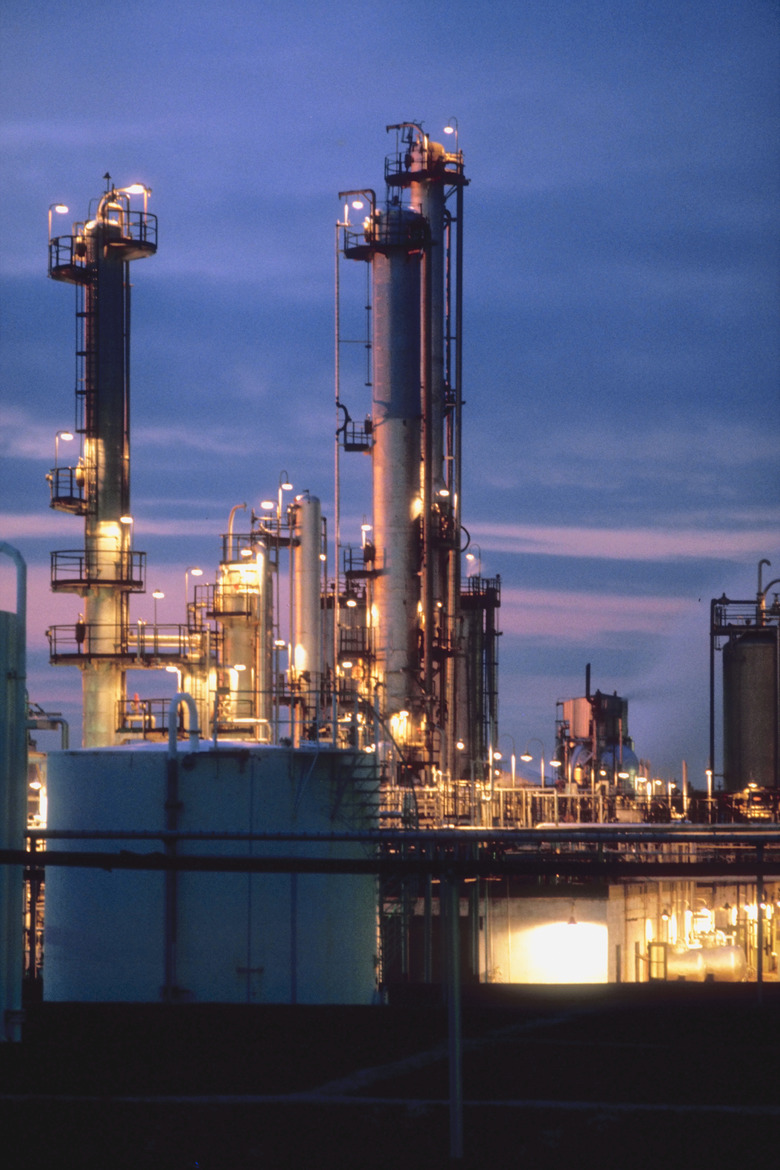How To Remove Moisture From Natural Gas
Natural gas accounts for 24 percent of the United States energy use. Before natural gas reaches your home it is processed to remove secondary elements until primarily composed of methane. Moisture is one of these secondary elements. Most of the free water in natural gas is removed with drip valves along the pipelines but the remaining moisture must be removed by further processing. The process for removing moisture from natural gas is very similar to the process for processing crude oil. The process of natural gas dehydration uses three methods: Joule-Thomson Expansion, Solid Desiccant Dehydration, and Liquid Desiccant Dehydration.
Joule-Thomson Expansion
Step 1
Pass natural gas into a heat exchanger to lower the temperature of the gas.
Step 2
Move the heated gas into a low temperature separator. As the gas rapidly cools, water vapor will form into solid ice crystals and drop out of the natural gas.
Step 3
Remove the dehydrated natural gas from the low temperature separator and continue on for further processing, if needed.
Solid Desiccant Dehydration
Step 1
Move the natural gas into the bottom of a desiccant tower.
Step 2
Pass the natural gas through adsorbents (silica gel, molecular sieve, activated alumina and activated carbon) until the desiccant tower reaches a maximum load.
Step 3
Move the natural gas into another tower while the first tower regenerates using an indirect heated portion of the processed gas.
Step 4
Move the regeneration gas into an air-cooled heat exchanger until the water crystallizes and drops from the gas.
Step 5
Return the regeneration gas into the processed natural gas and move the processed gas back thorough the first tower. Continue the process until the moisture level of the natural gas is at acceptable levels (4 lb. to 7 lb. per million standard cubic feet).
Liquid Desiccant Dehydration
Step 1
Move the natural gas into the bottom of a contactor tower.
Step 2
Pump tri-ethylene glycol (TEG) solution into the top of the tower allowing the TEG solution to flow downward across bubble trays.
Step 3
Continue moving natural gas into the contactor tower. The gas will pass through bubble trays contacting the TEG solution which will remove the water vapor. Move the dehydrated gas from the top of the contactor tower and continue into further processing, if needed.
Step 4
Collect the TEG at the bottom of the contactor tower and heat until the water in the TEG boils out. Return the regenerated TEG back through the top of the contactor tower.
Things Needed
- Low temperature separator
- Desiccant tower
- Desiccant
- Indirect heater
- Air-cooled heat exchanger
- Contactor tower
- Tri-ethylene glycol solution
Warning
Only trained personnel should process natural gas, and only in regulated facilities. Natural gas is highly flammable, use caution when processing.
Cite This Article
MLA
Hoskins, David. "How To Remove Moisture From Natural Gas" sciencing.com, https://www.sciencing.com/remove-moisture-natural-gas-8756813/. 24 April 2017.
APA
Hoskins, David. (2017, April 24). How To Remove Moisture From Natural Gas. sciencing.com. Retrieved from https://www.sciencing.com/remove-moisture-natural-gas-8756813/
Chicago
Hoskins, David. How To Remove Moisture From Natural Gas last modified March 24, 2022. https://www.sciencing.com/remove-moisture-natural-gas-8756813/
